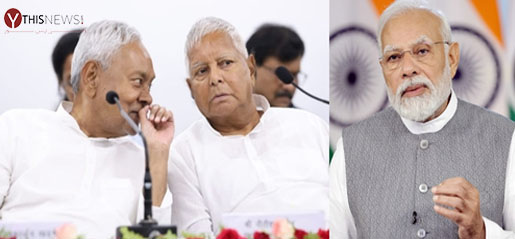Patna: Caste plays a pivotal role in shaping Bihar’s social landscape, influencing both personal choices and political preferences. People in Bihar often seek life partners and elect representatives from their own caste, driven by the belief that individuals from the same caste may better understand and represent their interests.
Recognizing this caste-based dynamic, politicians, particularly those in the ruling parties, have conducted caste-based surveys to reveal the true strength of various castes. Bihar Chief Minister Nitish Kumar and RJD leader Lalu Prasad Yadav, well-versed in Bihar’s complex caste equations, released the results of one such survey on October 2. Their objective was to dispel confusion among the people about caste numbers and prevent political parties from exploiting this confusion during elections.
The Bihar government’s comprehensive survey identified 215 castes and their respective populations. This move is akin to the Mandal Commission report initiated by Vishwanath Pratap Singh, which sought to address caste-based inequalities. Nitish and Lalu have strategically used this survey to counter the BJP’s caste-based politics, much like Singh did against the Congress, which was dominated by upper-caste representation.
Looking ahead to the 2024 Lok Sabha elections, Nitish and Lalu recognize that OBCs (Other Backward Classes) will play a crucial role. Prime Minister Narendra Modi is expected to leverage OBC support, especially in Bihar. Nitish and Lalu’s caste-based survey reveals the significant OBC and EBC (Economically Backward Classes) populations in Bihar, aiming to prevent the BJP from sowing confusion in the name of OBCs.
This move has created unease among upper-caste BJP voters, who constitute a smaller percentage (15.52%) in Bihar, including Bhumihars (2.86%), Brahmins (3.66%), Rajputs (3.45%), and Kayasthas (0.60%). In contrast, Nitish Kumar has a stronghold among voters from the Lav-Kush equation—Kurmis (2.87%) and Kushwahas (4.21%). Additionally, he enjoys strong support among OBCs and EBCs. Lalu Prasad has the backing of Muslims and Yadavs, comprising 17.7% and 14% of Bihar’s population, respectively. He also commands a sizable vote bank among Scheduled Castes (19%), EBCs, and OBCs. These factors give Nitish and Lalu an edge over the BJP.
Previously, the BJP, with its smaller upper-caste base, dominated the larger OBC, EBC, and Scheduled Caste populations. Lalu Prasad’s leadership and subsequent empowerment of marginalized castes shifted this equation. Bihar’s lower-caste population has realized that the BJP primarily represents upper castes, making them reluctant to align with the party. The BJP’s inability to secure a majority government in Bihar on its own is a testament to this shift. Nitish, too, understood that his individual strength would not suffice, prompting him to seek support from either the BJP or the RJD.
Lalu Prasad has emerged as the biggest beneficiary of the caste-based survey, as it reaffirms his support base among Muslims (17.7%) and Yadavs (14%).
While political parties were aware of their core voters’ strength, this survey has empowered voters by providing them with precise numbers. It effectively eliminates the possibility of any party exploiting confusion regarding caste demographics.
In response to these revelations, the BJP has initiated the narrative of Hindus versus Muslims in Bihar, attempting to shift the focus from caste to religion. The survey, based on Bihar’s population of 13.7 crores, highlights that Hindus constitute 81.9%, Muslims 17.7%, Christians 0.05%, Sikhs 0.01%, Buddhists 0.08%, Jains 0.0096%, and other religions 0.12%.
Some BJP members, like MLA Haribhushan Thakur Bachaul, have even proposed declaring Bihar as a Hindu state to discourage caste and sub-caste-based polarization.
During his visit to Patna on October 4, BJP national president Jagat Prakash Nadda instructed party MPs to gather feedback from voters and build strong relationships with them. He emphasized the importance of women’s reservation, focusing on the OBC vote bank, targeting Lalu Prasad while avoiding criticism of Nitish Kumar and alliance partners.
(This story is sourced from a third-party syndicated feed. Raavi Media takes no responsibility or liability of any nature. Raavi Media management/ythisnews.com can alter or delete the content without notice for any reason.)


